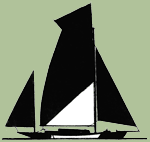
Building and restoring classic wooden sail, row and power boats with the finest boat building materials and craftsmanship. |
Like the Albert Strange Yawls By Thad Danielson |
You can sail anywhere the water goes at your own pace. Sailing where you would like to go in a reasonable time is nice and maybe even important, but most important for the clever little yacht is confidence in your vessel and the pleasure brought to the crew, sailing and moored. "The Development of the Small Cruiser" was chronicled by William P. Stephens in his TRADITIONS AND MEMORIES OF AMERICAN YACHTING and many yachting writers the last 150 years have contributed to the written record. Yachting as we know it started with big boats needing big crews but smaller boats had long been the favoured means of transportation along the waterfront.
"The Development of the Small Cruiser" was chronicled by William P. Stephens in his TRADITIONS AND MEMORIES OF AMERICAN YACHTING and many yachting writers the last 150 years have contributed to the written record. Yachting as we know it started with big boats needing big crews but smaller boats had long been the favoured means of transportation along the waterfront.Reading Nathanael Herreshoff's RECOLLECTIONS (Herreshoff Marine Museum) about his early sailing experiences, it is fun to see how much cruising the Herreshoff family did in their many sail boats, all under 35'. He describes sailing all around Narragansett Bay in his brother's 12' sloop METEOR, built in 1857. When brother John built a new boat SPRITE, 20' 3",in 1860, they sailed in company with their father's 22' JULIA from Bristol to New York, and back, for a look at the steamship GREAT EASTERN (3 in one boat 4 in the other, they made the passages each way in 28 hours). Nat was then 12 years old. Over the next couple of years they regularly cruised SPRITE between the Vineyard and Long Island. When John sold SPRITE in 1862, he built KELPIE, 27'. Toward the end of a cruise to Boston around Cape Cod, they were challenged to race at Vineyard Haven and having won the race John was asked to build a boat for the man they beat, beginning John's boatbuilding business, to become the Herreshoff Mfg. Company when Nat joined John in 1878. Nat's RECOLLECTIONS show that small yachts cruised all around the coast of New England in the 1850's and 1860's, for he often describes encounters with other yachts of modest proportions. W. P. Stephens credits the British R. T. McMullen and John MacGregor (along with E. E. Middleton) with starting the development of a small boat cruising. The Herreshoffs and certainly thousands of others around the world had cruised for pleasure and interest in their small boats over the years, but with the industrial development of the city in the 19th Century the need for recreation was felt by all levels of society. In the late 19th century public interest in yachting blossomed. Spectators thronged to the shore watching yacht races and writers eloquently covered yachting events large and small in the press. People around the world came to hear Joshua Slocum talk about his solo sail around the world, as they had earlier followed in words the small boat cruises of McMullen and MacGregor's voyages in his ROB ROY canoes. Through publicity of the day and then his book DOWN CHANNEL, McMullen showed that small boat cruising was possible. With the Rob Roy canoes MacGregor began the development of a small boat type purposely designed for cruising. Many people were inspired by the experiences of McMullen and MacGregor to explore rivers, canals and coasts, as well as undertaking offshore passages. While the Herreshoffs and other well known builders produced many smaller boats with cruising ability they were best known for their big yachts and racing boats. Much of the design work in small cruising boats was done by amateurs, usually people who were looking for better boats for their own cruises. Periodicals like YACHTING MONTHLY in England and FOREST AND STREAM in the United States regularly carried drawings and reviews of new designs. Albert Strange (1856-1917) was very well known in England from the 1880s until his death in 1917 especially for his one and two person cruising boats. Strange began designing cruising canoes, but with more and more interest in extensive cruising, his boats became more capable and comfortable, in total more than 150 designs leading to more than 180 boats. Through his correspondence with W. P. Stephens these designs became more widely known. A few years ago I became custodian of SEA HARMONY, the last of a series of four boats built to Albert Strange's last design. The design developed from the Suffling brothers desire for a boat in which they could cruise together. The Sufflings had cruised extensively in smaller boats designed by the young Harrison Butler but wanted a boat for comfortable cruising together. As designed, VENTURE was a 29 foot counter stern gaff yawl. After building and cruising in VENTURE, they had the slightly larger 33 foot CHARM built and then an even larger CHARM at 40 feet. In 1937 they went back to the builder of the CHARMs and had SEA HARMONY built, a near sister of the first CHARM. I think of SEA HARMONY as the last of the Albert Strange yawls and the perfect two person cruising boat - that was what the Sufflings were after and these four boats still show how successful they were. 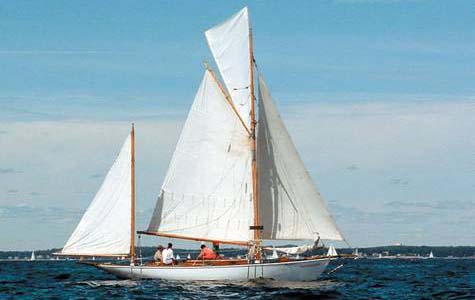 SEA HARMONY in light air but clearly more aloft, filling the topsail. 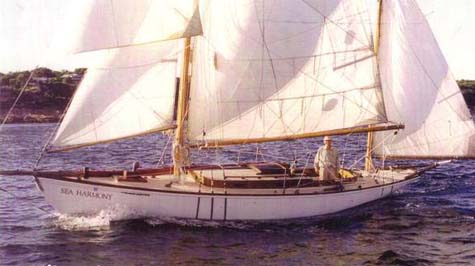 Then there is this picture when it was blowing! but still easily handled. Fortunately, everyone's idea of perfection is not the same. Many other designers, builders and owners over the last century and a half have contributed to a stock of wonderful plans for boats that we can enjoy. Nathanael Herreshoff boats and building methods are a great legacy with many modest designs that could be investigated for reproduction. Ralph Munroe's round bottom sharpies offer well thought out shoal draft capability, though actual plans exist only in the interpretation of other designers. Alden, Crocker, Rhodes, L Francis Herreshoff, and others have designed small cruising boats worthy of building. Laurent and Morgan Giles have designed some great little cruising boats, as have other English designers. The Albert Strange yawls are remarkable even in this company. With length you get speed, but small cruisers with low aspect sail plan such as these make a pleasure of being where you are, in a solid vessel at sea or anchored in a quiet cove, and they go beautifully, with narrow beam they are easily driven for their weight. SEA HARMONY has a beam of 7 feet 8 inches; a few years ago I had a couple aboard who said they had looked at lots of boats but even with 10 feet of beam few had more USEABLE space than SEA HARMONY. Albert Strange was an artist, teacher of art, and longtime director of the Scarborough (England) School of Art. W. P. Stephens says, "He knew the sea, what it liked and disliked, much of his personal sailing was done in small craft, and all of his yachts were noted for power, stability and sturdy construction. While the artistic side of his nature was evident in the lines of his yachts, of equal importance was the practical side; the thoroughness of construction shown in all of his specifications." Also, "The many designs of Albert(sic) Strange are in no sense dated; and, though thirty years old, are still perfectly adapted to their original purpose." This written some 60 years ago. In corresponding with Stephens, Strange sent many of his designs. Fortunately these are now preserved at the Mystic Seaport Museum and available from the Ships Plans Department. 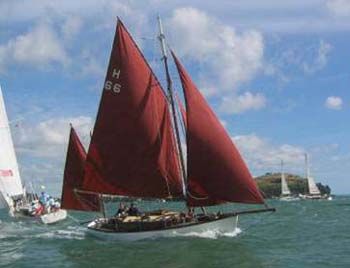 SHEILA, 25'x19.5'x6.75'x3.42', was designed in 1904 by Albert Strange for his friend Robert Groves. She is still actively sailed today, showing her capabilities as she does in this drawing by her original owner. Then there is IMOGEN, 25.75'x22.5'x8'x3.5', now in New Zealand as pictured on the right at the Classic Yacht Regatta, February 2005:
SHEILA, 25'x19.5'x6.75'x3.42', was designed in 1904 by Albert Strange for his friend Robert Groves. She is still actively sailed today, showing her capabilities as she does in this drawing by her original owner. Then there is IMOGEN, 25.75'x22.5'x8'x3.5', now in New Zealand as pictured on the right at the Classic Yacht Regatta, February 2005:Of the 24 to 25 foot boats like SHEILA, NORMA is typically attractive, a fine pocket cruiser. In a size closer to SEA HARMONY is the SHEILA II 31'7"x24x8'x4'11", a later boat for Robert Groves. There is a book called SHEILA on the Wind by Adrian Hayter about his cruise from England to New Zealand in SHEILA II after WWII. Now 94 years old, she is now undergoing restoration for the mayor of Auckland. The beautiful shapes and elegant accommodations in these hulls with well thought out rigs for one and two person cruising make these designs especially attractive. Strange liked the big jib with no inner forestay to require the single hander on the foredeck, and he designed a jib roller furling gear so all could be done from the cockpit. People look at the topsail gaff yawl rig and think it complicated, but with the mizzen set and sheeted in she will sit quietly head to wind while the other sails are set or furled, underway only the jib sheet must be handled when changing tacks and shortening sail for a blow is easy with the varied options offered by the split rig. 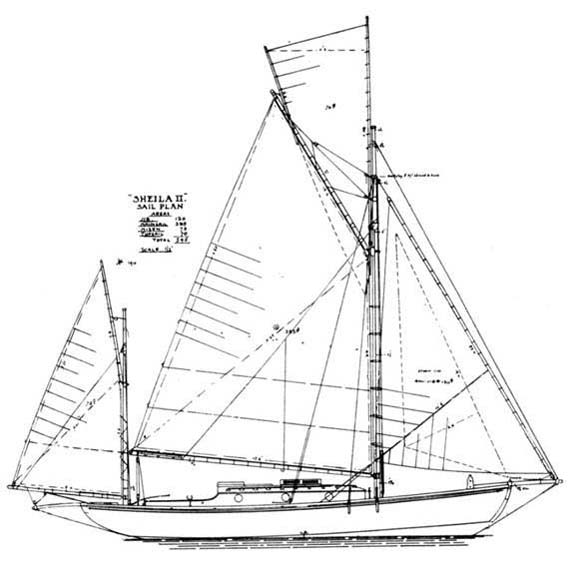 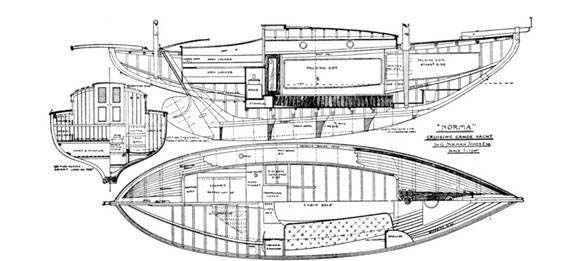 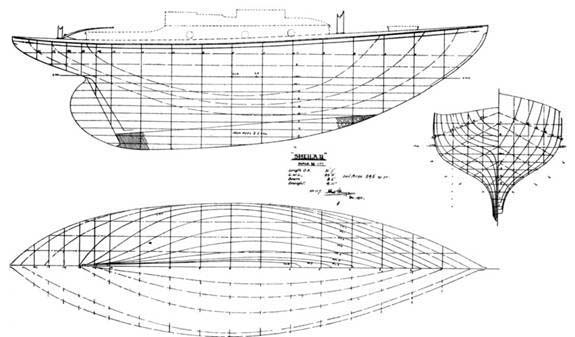 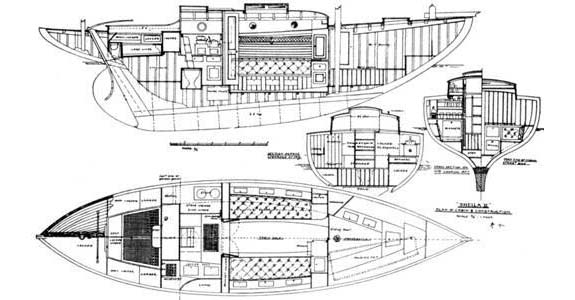 SEA HARMONY now has a small diesel engine and a few Strange designs were drawn with engines. N. R. Suffling wrote an article for Yachting Monthly after the brothers first cruise in the near sister CHARM ending with this defence of the yawl rig: "I see one writer who owns a fine cutter with a motor recommending his rig in preference to the yawl. I quite agree that if you have a motor it does not matter if you have one mast, or two, or none!" In today's crowded harbors an engine can seem necessary, but these boats sail so nicely and sit so solidly in the sea that you might well prefer a nice dinghy (and a cell phone) for communicating with the shore. |